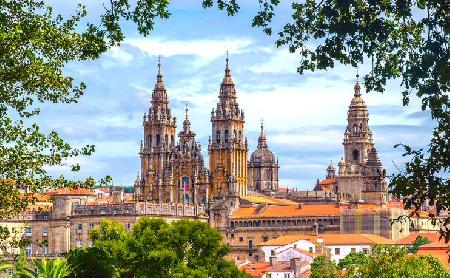 This ancient city is a Catholic sanctuary, a point of attraction for hundreds of thousands of pilgrims. The magnificent Santiago Cathedral is the final goal of the great Pilgrimage Route, known to believers around the world as the Camino de Santiago.
This ancient city is a Catholic sanctuary, a point of attraction for hundreds of thousands of pilgrims. The magnificent Santiago Cathedral is the final goal of the great Pilgrimage Route, known to believers around the world as the Camino de Santiago.
In the 9th century the tomb of the Apostle Santiago was discovered here, and by the beginning of the Middle Ages the city had become the third most important pilgrimage site in the Christian world. In the Middle Ages, up to two million people traveled here on foot each year. Today, the ancient pilgrimage route through northern Spain still attracts pilgrims to the city's elegant cathedral, joined by tourists who want to see one of the most beautiful cities in the world.
The old town:
The entire old town of Santiago de Compostela is a UNESCO World Heritage Site. It is an atmospheric maze of old narrow streets, old buildings and churches, located south of the Cathedral. There are Romanesque and Baroque temples, old mansions and palaces - among which are several original buildings and others that have been restored.
Obradoiro Square:
The cathedral's western baroque façade faces Piazza Obradeiro. In addition, the Plaza del Obradoiro complex is made up of three other historical granite buildings built at different times: on the south side is the Colegio de San Jerónimo, in front of it the Renaissance Hospital of the Catholic Monarchs (now the luxurious hotel Reis Catolicos), then the neoclassical Rahoi Palace, where the town hall meets. In the center of the plaza is an eight-ray star, symbolizing the end of the pilgrimage route.
Santiago's cathedral:
The Cathedral of Santiago de Compostela completes the pilgrimage route. The main sanctuary of Spanish Catholics is named after the Apostle Santiago (Santiago Matamoros). The saint's relics, found by the monk Pelayo in 813, are kept in the crypt. The cathedral has been rebuilt several times: in its appearance the features of the early Romanesque, Gothic, Baroque and Churrigueresque were combined. The needles are up to 80 meters high.
The Rajoy Palace:
The four-story Rajoy Palace, with a monumental archway below and an impressive neoclassical portico, was built in 1772 by Carlos Lemore on the initiative of Bishop Bartolomeo de Rajoy. On several occasions, the Rajoy Palace was a consistory, a pilgrimage house for the clergy, a prison, and the residence of the canons. Today it houses the Town Hall and the Regional Parliament.
Hospital of the Catholic Monarchs:
The Hospital of the Catholic Monarchs is a three-story Plateresque-style building. By decree of the kings Fernando and Isabel, a hospital was founded in 1501-11 in the Plaza Obradeiro for pilgrims who needed medical attention and rest at the end of their journey. In the 20th century, the name of the Hospital was changed to Hostal de los Reyes Católicos.
University of Santiago de Compostela:
Founded in 1495. Over the past few centuries, the institution has evolved from a "grammar school" to a modern international university with more than 40,000 people including students, faculty, and other staff.
Gelmírez Palace:
The Gelmírez Palace was the former palace of the Bishop of Santiago de Compostela. It is next to the north tower of the cathedral. The Gelmírez Palace, built in the 12th century, was partially rebuilt in the 16th and 18th centuries. - An example of the Galician Romanesque style in civil architecture.
Santa María de Sar:
Santa María de Sar is an old Romanesque monastery church that dates back to the 12th century. It is a three-corridor building, divided by arched columns. The ribbed vault creates a feeling of space. The church has a small inner courtyard with a garden.
Immaculate Square:
Plaza de la Inmaculada is a square space enclosed between the north facade of the Cathedral and the main portal of the Benedictine monastery. The Plaza de la Inmaculada is considered one of the main historical squares and the end point of the pilgrimage route.
Plaza Quintana:
The two-level plaza in Quintana adjoins the Puerta Real de la Catedral. Locals call it Plaza de los Muertos, and for some reason it was built on the site of an old cemetery. There is a wide staircase between the cathedral and the monastery building of San Paio Antealtares. The main attractions of Plaza Quintana are the Cassa da Para mansion and the Berenguela clock tower.
Platerias Square:
The Plaza de las Platerías is famous for its jewelry stores. In the center is the Fountain of the Horses, crowned by the figure of an Angel with a guide star. The Plaza de Platerías faces the south façade of the Cathedral, where the Cabildo House and the old Banco Español are located.
